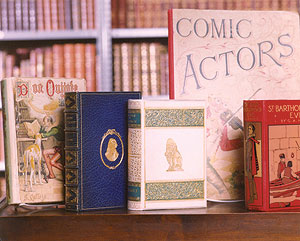
Children’s books make a fun and informative specialty choice for collectors.
By Amy Whorf
Children are often the recipients of new books, at least new to them. Adults who purchase them enjoy picking titles that they recall fondly from their own childhood. In some cases it’s to re-read themselves or for the first time while reading aloud to the next generation. The post-holidays are a good time to encourage their habits of reading the time-tested tomes from many genres.
The Secret Garden, The Tale of Peter Rabbit, The Wizard of Oz, Tales from Grimm, Anne of Green Gables, The Wind in the Willows: treasured stories that have endured through the generations. Children’s books today now represent one of the fastest growing segments of the publishing market. The record-breaking Harry Potter phenomenon in recent years made young people and books more inseparable than ever. It is not only enthusiastic readers who welcome the plethora of offerings, but collectors also have discovered the charms of children’s books.
“Collecting,” says Kenneth Gloss, proprietor of Boston’s Brattle Book Shop, one of the oldest continuously operated antiquarian book shops in America, “is a personal choice, so there is no right or wrong way to collect, especially in the broad and diverse field of children’s books.”
Among the less obvious collectibles that Gloss includes as “children’s books” are old Horn Books, New England primers, old readers and Tract Society publications. He notes a renewed interest by collectors in the boys’ series such as Horatio Alger, Tom Swift and The Hardy Boys. Some collectors, adds Gloss, “acquire many versions of a particular story, like Robin Hood or A Christmas Carol, which has been retold and re-illustrated over the years. Others collect only Caldecott and Newbery winners. My advice to anyone beginning a collection for themselves or for youngsters is to specialize; give a focus to the collection.”
One way in which collectors give focus to their collection, says Gloss, is by collecting first editions, limited editions, or signed editions. Renewed appreciation for the classics has spawned a flurry of reprints that in turn have piqued interest in the original edition. “First edition is a key term that people hear. I point out that most books that came out in a first edition never came out in a second and probably should not have had a first edition to begin with! First edition really means something if the book is distinguished by its author, its subject, or its illustrations. In other words, there must be some appeal to collectors that puts the book in demand. Ultimately, it comes down to supply and demand. First editions of children’s books can be quite rare and valuable because children’s books were generally not published in large numbers.
“Condition can also be very important in assessing the collectibility of a book,” says Gloss, “but a less than perfect condition can be overlooked if the book is a rarity. The slightest mar in the dust jacket of a modern book can reduce the value of that book to a fraction of what it might be worth if the jacket were in mint condition. Other intrinsic characteristics that make a book collectible are beautiful illustrations or high quality leather bindings. I have to stress that each book must be appraised on its own merits, as an individual item. Every collector or gift-buyer must determine his or her own reason for collecting or for purchasing for another. Not everyone cares about investment value. Many people collect or give for aesthetic, sentimental or historical reasons.”
For whom one will be collecting, be it a toddler, pre-teen, young adult, or oneself, is another consideration. “The sentimental journey made by many new parents in searching for their own favorites,” says Gloss, “is a good way to begin to give a child’s library a focus.” The pleasures in recollecting one’s own childhood reading memories is a positive way to impart to a child the excitement and joys of reading.
Gloss believes that the correct introduction to books can make all the difference. He tells the story of a five-year old in East Boston who was read adventure stories by his teachers. So entranced was the child by tales of heroic deeds, mischief, and travel that after school each day he retold the stories to his young friends. This five-year old was Gloss’ late father, George Gloss, who made books and the Brattle Book Shop his life’s passion.
Familiarize yourself with the field of children’s books by going to book shows and browsing the children’s section of a good bookstore including second-hand book shops or a library. There’s a vast range of general fiction, fairy tales, mystery, folk tales, adventure, poetry, humor and animal stories appropriate for young and young-at-heart readers.
Local libraries and their librarians are amazing resources as is the constantly growing accessibility of information on the Internet. Don’t forget other parents who can share their own children’s experience with specific titles or content.
Now, if you happen to run across one of the first editions of Harry Potter books, please call Ken. He says that today they sell for $20,000 and up! Remember his guideline about rarity? Not many were printed, as the publisher had no idea it would be such a runaway bestseller.
The Brattle Book Shop is located at 9 West Street in Boston’s Downtown Crossing section and open Monday through Saturday, 9:00 a.m. to 5:30 p.m. More information is at www.brattlebookshop.com or call 800-447-9595. Ken has often been seen as a guest book appraiser on PBS’ “Antiques Roadshow.”
Amy Whorf is a Hingham-based writer and photographer and author of “My Provincetown.”












Reader Comments